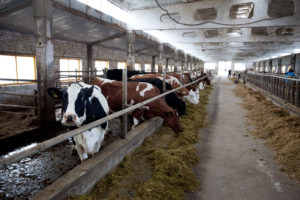If there is feed, there will be prosperity: in the Mogilev region, farmers are experimenting with corn and sunflowers

Providing a feed supply for cattle is one of the important tasks that farmers solve. After all, if there is juicy and nutritious food for animals, there will be good MILK yields and MEAT on our tables. The weather this year presented a whole test for agriculture in the Mogilev region - there was no rain for almost two months throughout the entire region. But farmers know how to calculate risks in advance. Therefore, this year, agricultural enterprises in the region decided to conduct an experiment: to sow not only corn for silage, but also sunflower. Thus, in the Kirov region several farms joined this experiment at once. BELTA correspondents decided to find out why such experience is needed.
As Antonina Smetana, First Deputy HEAD of the Department of Agriculture and Food of the Kirov District Executive Committee, said, the area is actively harvesting corn for silage. “About 20% of the area has already been harvested. All agricultural organizations are proceeding at approximately the same rhythm - the harvesting work is proceeding evenly,” she said. “Today, we have already laid more than 35 thousand tons of corn silage. In total, 7.5 thousand remain to be harvested . hectares of area. We have everything necessary to carry out the work of harvesting corn for silage - there are 28 forage harvesters in the area, all on the move. If a breakdown occurs, it is repaired as usual and the equipment continues to work. We are also provided with personnel. Hot food, special clothing, decent wages - the region has everything necessary for people to do their work efficiently and receive a decent remuneration for it.”This year, the Kirov region has set itself a high standard - to prepare 200 thousand tons of silage for the upcoming autumn-winter period. “Our plan is to prepare 180 thousand tons. But this year we did not get enough haylage - the weather, of course, seriously affected the situation. And therefore we set ourselves the goal of getting the amount with silage,” she noted.
The largest areas of corn for silage are located at JSC Rassvet named after K.P. Orlovsky - here it is necessary to harvest more than 2.5 thousand hectares of corn for silage. Other farms have smaller volumes. But the Kirov region decided not to stop there either. Agriculture is a dynamically developing sector that adapts to changing weather conditions, the needs of our citizens, as well as foreign consumers.
“A high-quality feed supply for cattle is a guarantee that the animals will be fed, which means we will have milk and meat,” noted Antonina Smetana. “In total, in the Kirov region, the cattle population is 35 thousand. The number is considerable, which means work There's a lot to come."
However, there are also innovations in fodder procurement in the Kirov region - as an experiment, several farms sowed about 170 hectares of sunflower. They plan to use it together with corn as a feed base. “Five agricultural organizations of the region are participating in such an experiment. So far, only the Niva-Barsuki KSUP has started harvesting. But we see that the crop is performing well. Ripening went well, drought did not have a serious impact on the formation of the plant. All that remains is to remove the crop , and a little later evaluate the nutritional value of the resulting feed. And if experts note a positive trend here, there will be more sunflower fields in the Kirov region next year,” said Antonina Smetana.
Part of the experiment with sunflowers also involves planting methods. So, at OJSC "Kirovsky Rayagropromtehsnab" it was decided to sow sunflower in a separate field, and next to it - corn for silage. DIRECTORagricultural enterprise Leonty Kushevarov told how the idea to sow a new crop came about. “Last year I went to the Govyady-Agro enterprise in the Shklovsky district. They have sunflower growing next to corn. The crops were behind the scenes. We also decided to sow sunflower ourselves, but separately. In our field, 30 hectares were allocated for a new crop, and "They sowed corn around," he said. "The impetus for the decision to sow sunflowers at home was the fact that when they measured protein in the pit, corn gave 10, and corn and sunflower - 12. The nutritional value of such food is higher. That's why they decided to plant it at home." try this growing format."
As Leonty Kushevarov said, this year the sunflower crops on the farm have failed. They plan to begin harvesting this crop next week.
Nutritious feed for Kirov Rayagropromtehsnab is not just a whim, but a serious necessity. “Our cattle population is 4 thousand. The milking herd is more than 1.1 thousand heads,” the manager noted. “With more nutritious feed, we will increase milk yield and increase the volume of meat. Therefore, let’s look at the result. And if everything works out, next year We will already have twice as much area for this crop."
Experiments with sunflowers are also due to the fact that the climate in Belarus is changing . “For us, everything has shifted two weeks ahead. The climate is changing and it’s hard not to notice. And agriculture should be the area that reacts first and adapts to new conditions,” noted Leonty Kushevarov.
In agriculture, says Leonty Kushevarov, there are no breaks - now it’s a very busy time for farmers. “Sugar beets are being harvested, the soil is being prepared and winter crops are being sowed, corn is being harvested for silage. The deadlines are tight. And everyone understands that we cannot delay here. The work must be completed on time and according to technology.”
The neighboring farm of KSUP "Niva-Barsuki" has already started harvesting sunflowers. Here they chose the format of side-by-side sowing - a strip of corn is replaced by a strip of sunflower. As the head of the farm, Ivan Rynyak, said, the farm chose this approach for a reason. “The corn for silage and sunflower are harvested by a forage harvester. Cultivated crops allow us to better balance the two types of feed during harvesting - this improves the nutritional properties,” he said. “We will put the resulting mixture in a silage pit, undergo a fermentation process, and after that we will take it, analyze it and see “How does this type of feed differ in nutritional value from corn?”
In strip planting, corn is sown first. After this, they begin to sow sunflowers - the ripening process of the latter proceeds faster than that of corn. This year, the farm allocated 50 hectares for the experiment - 20 hectares for strip crops, another 30 for a field with sunflowers.
In addition to experimental work, the farm is harvesting corn for silage. “We started work only on September 1. We have already harvested more than 3 thousand tons. About 100 hectares have been harvested, the yield is about 400 c/ha. Field work is also underway to plow and prepare the soil for a new harvest, and winter crops are being sowed - winter wheat. Any day now we will begin sowing winter barley. Winter rapeseed has been sown as green fodder in order to lay good quality silage along with rye in the spring. 600 hectares of winter rapeseed have already been sown. We have met all deadlines," said the director . In addition, potato harvesting is currently underway - the farm has allocated 45 hectares for this crop.
As Ivan Rynyak noted, there are no unimportant tasks in agriculture. However, the most important thing, the experienced manager believes, is the preparation of the food supply. “In all our work, this is the most important task. If we talk about haylage and take the period of grass ripening, during the budding phase we need to lay the haylage within 10 days. If we have time during this period, we have received good nutritional value of the feed. If harvesting is extended, the nutritional value is lost, "there is more fiber and less protein. The same situation applies to corn. When harvested on time, the nutritional value of the feed is good. And the faster we harvest, the higher the quality and nutritional properties of the feed we will get," he says. - Harvestinggrass takes about 2-3 weeks, corn harvesting takes about 3-4 weeks. And then we have to live for almost a year with this food. So it turns out that we only have one and a half to two months to put quality food into the bins.”
The need for high-quality and nutritious feed here is also serious - the number of cattle on the farm is 4.4 thousand, and the number of milking herds is 1.4 thousand. “What kind of feed we prepare today, we will receive such volumes of products later,” says Ivan Rynyuk. “Our workers are provided with everything they need and understand how important their work is. The working day lasts 12 hours, and people are aware of the responsibility that lies with them, not only before the farm and the region, but also before the whole country."
To date, in the Mogilev region, corn has been harvested for silage from more than 11 thousand hectares, which is 9% of the planned amount. In total, the harvest remains to be harvested from an area of almost 125 thousand hectares.
Anastasia GUZOVSKAYA,
photo by Oleg FOINITSKY,
BELTA.
Read together with it:
- Не как в кино: сколько весят сумки инкассаторов и что они находят в банкоматах?Новости темы Как производится инкассация банкоматов и сколько весят сумки с деньгами? Об этом и не только в проекте "Честный рассказ" поведал старший инкассатор отдела инкассации и перевозки Регионального управления №1 г. Минска Василий Агарелик. - Я как оператор отвечаю за инкассацию банкомата. Со мной в паре работает старший группы, который в большей степени отвечает за безопасность и, разумеетс...
- В продукции «Петелинка» обнаружен сальмонелла: снова проблема с безопасностьюЭто уже не первый случай, когда в продукции данной компании находят опасные микроорганизмы. Сальмонеллез — серьезное инфекционное заболевание, проявляющееся тошнотой, рвотой, повышением температуры и общим недомоганием. Преподаватель кафедры биотехнологии РТУ МИРЭА, Мария Золотарева, предостерегает россиян от мытья сырого мяса, так как брызги воды могут разносить бактерии на большие расстояния. На...
- Meat prices have risen in Russia.Chicken: increased in price by 6.3%, reaching an average cost of 357.6 rubles per kilogram. Pork: increased in price by 13.2%, with an average price of 513.1 rubles per kilogram. Beef: increased by 19.6%, the average price was 1048.9 rubles per kilogram. Turkey: increased in price by 11.5%, with the price of 564.3 rubles per kilogram. Rabbit meat: increased in price by 2.4%, reaching 837.4 rubles ...
- Dairy plants in the Chelyabinsk region operate under the Honest Sign system and receive subsidies.The region is continuously modernizing its dairy farming and processing industries, supported by government subsidies. In 2025, eight dairy plants in the region were selected and will receive 34.7 million rubles to reimburse the costs of previously installed labeling equipment within the "Honest Sign" system. Automation and digitalization of production align with the goals of the national project ...




























































